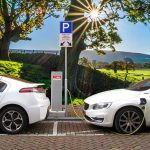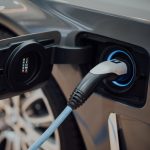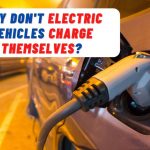Last Updated on October 1, 2022 by
Electric vehicles do not need an engine coolant. Electric vehicle (EV) is a vehicle that works on electric motor and not on the internal combustion engine system. Vehicles with internal combustion engine creates energy or power by burning gases and fuels mixture.
That is why electric vehicles are a good possible replacement option for existing automobile generation.
Given the global warming, rising carbon footprint and climate change issues coupled with depletion of natural resources has given a flip to demand for EVs.
The concept of electric vehicles has been around for some time, however it is only in the last decade or so there has been a push for EVs to replace traditional vehicles globally.
Though EVs use lithium-ion batteries, heat generation happens like it happens in combustion engine vehicles. Consequently, a coolant is a requirement for EVs.
What is the coolant used in electric vehicles?
The cooling system of electric vehicles (EVs) is completely different from the cooling system of internal combustion vehicles. The cooling system of an electric vehicle is cooling the battery pack temperature along with the electronics in the system.
There are several methods to cool down the batteries coupled with electronics of an electric vehicle such as using a coolant or air conditioning system or using a refrigerant. Different companies are using different methods.
Majority of the electric vehicles use a system called cooling loop. The loop in most cases contains ethylene glycol but can also use water or refrigerant coolant which circulates within the loop using an electric pump.
Ethylene glycol gets circulated in the loop and goes through the pack of batteries and other electronics in the loop. The loop has a radiator which allows the heat release in to the outside air.
The flow rate of the cooling liquid and the temperature in particular vary. The flow rate of the coolant for electric vehicles at low temperature is roughly 500 L/h and the rate for combustion engine vehicles at high temperature is 5000 L/h.
In most electric vehicles the coolant should last for a lifetime and does not require refills. However, if the coolant level goes down then your car indicators will let you know the same.
So, do electric vehicles need coolant? Yes, they do!

What fluids do electric cars need?
Traditional internal combustion engine vehicles require lubrication to wax the pistons, valves and other related moving parts to function smoothly past each other at high speeds. To ensure that all the mechanical parts of the engine runs smooth at all times you need to ensure lubricant checking and re-filling regularly.
When it comes to electric vehicle’s lubrication is not needed. Electric vehicle requires a pack of batteries to work the electric motor which helps run the car.
The electric motor in an EV is sealed along with the required lubrication. The same may be changed as guided by the manufacturer maintenance chart or earlier in the even there is a functionality problem.
The electric vehicle requires following fluids and routine checkups on them:
- Coolant: All electric vehicles require coolant to flow through the thermoregulation loop system to prevent overheating of the batteries and other electronics. You may need to change or add coolant during your regular maintenance cycle.
- Windshield Cleaning Fluid: Based on your use, the windshield cleaning fluid needs checking and refilling.
- Brake Fluid: Electric vehicles have regenerative braking system which relies heavily on the brake fluid to function smoothly. As a general thumb rule, the brake fluid in the EVs need changing every 25,000 miles or 45,000 Kilometers.
Do electric cars have brake fluid?
Electric vehicles use a regenerative braking mechanism. In regenerative braking the kinetic energy generated when the brakes are on to slow down the car is captured and used to charge your electric vehicle batteries.
In the internal combustion engine vehicles the kinetic energy generated when brakes are on is wasted. The vehicle slows down due to the friction between the rotors and the brake pads and the majority of kinetic energy generated wastes as heat.
The regenerative braking system recaptures almost 70% of the kinetic energy that is generated when brakes are applied. The amount recovered varies from manufacturer to manufacturer of electric vehicles.
Regenerative braking system provides a lot of force to stop the vehicle on its own, but electric vehicles also use conventional hydraulic brakes. Since the majority of braking occurs by the regenerative system the rotors and brake pads have lesser wear and tear.
In electric or internal combustion engine vehicle the purpose of brakes is to slow down the car and during that process of braking kinetic energy is generated due to friction. In both the cases brake fluid is required for smooth braking and to ensure longevity of the rotors and brake pads.
Do electric cars need lubricants?
Electric cars use vastly different drive lines, so you don’t have to ever worry about changing the oil during your routine maintenance drill. The internal combustion engine (ICE) cars require oil to ensure that the parts are well waxes as they move between each other.
The ICE car engine uses pistons, valves and other mechanical parts which cause friction as they move inside the engine. To ensure that these parts continue to function at their optimum need for oil in the internal combustion engine arises.
The high speed movement of mechanical parts in the ICE leads to accumulation of atomic metal residue in the oil. You have to change the lubricant from time to time in the ICE powered car.
In case of electric vehicle this is not required, as EV is powered by consuming battery while running an electric motor. The lubricants inside the electric motor are sealed and EVs use drivetrain that is completely different. It does not require frequent or routine change of lubricants.
Do electric cars have water pumps?
Electric cars generate heat and require a cooling system, water pumps help in cooling down the electric cars.
EVs mostly don’t use air cooling technology because it is not efficient and consistent as liquid cooling. There are several variables in the EV (similar to ICE) that require consistent cooling at all times.
There are several parts and components inside an electric vehicle that generate heat, but they do not generate heat equivalent to internal combustion engine vehicle. This leads to designing different cooling systems for EVs.
Do electric vehicles need coolant? Let’s find out more about cooling systems.
All EVs have slight variations in the components that require cooling. However, following are standard in most EVs:
- Electric Motor
- Inverter
- Batteries
- DC converter
In most EVs there are two or three electric water pumps which are part of the EVs cooling system. These come on when the EVs engine and other components require cooling.
Is there a radiator in electric vehicle?
Traditional internal combustion engine (ICE) cars have radiators to help cool down the engine and other related components. The EVs do not have many moving parts and engine like ICE cars and the heat generated in EVs is primarily from the batteries which is used to power up the car.
The heat generated in an EV is due to the batteries. The cooling system that EVs need is called heat exchangers close to their batteries for cooling.
When EV is in motion or getting charged the batteries start to heat, faster the discharge or charge, higher is the heat generated. There are two ways to cool EV batteries and electric motors:
- Air Cooling System: This method is used to cool down the batteries with passive and active airways. Passive cooling takes the outdoor or the cabin air to cool or heat the batteries.
Active cooling uses air from the air conditioner that has evaporator and heater to control the temperature.
- Liquid Cooling: This is a popular way to cool EVs. The cooling liquid runs through the cold plates, tubes and other components surrounding the batteries and takes it to the radiator or heat exchanger.
Electric cars which use liquid cooling to reduce the heat in the batteries and other components of EV use radiators.
FAQ relating to electric vehicle coolant
The most frequently asked questions about electric vehicles is if they need to have a coolant. The answer lies in whether you need liquid cooling for your EV or air blast cooling.
Consequently, it all depends on the category of the EV that you own, as coolants are based on that. To answer the question, do electric vehicles need coolant, the answer has to be “yes”.
Do electric cars use any fluids?
As there are several fluctuations that electric vehicles experience in terms of high speeds and power flows they have to have fluids. They need oil to reduce gears, and special oils for EVs that are more enhanced.
Do electric cars need oil or coolant?
Electric vehicles need both oil and coolants. This is because their batteries heat, so you need coolants.
In terms of oil, they need oil for transmission, and special oil in case cooling systems need to be enhanced, depending on the vehicle.
If you want to answer the question, “Do electric vehicles need coolant?”, now you know the answers!
How long do electric car batteries last?
In an electric vehicle, most batteries tend to last about five to eight years. Nonetheless, the newer and more current electric vehicles have batteries built to last ten to twenty years.
Do electric cars have transmission fluid?
Most electric vehicles face speeds of almost 15,000 revolutions in a minute. Power flows are also extremely high.
Considering this, they need oil for gears and transmission, besides other fluids like coolant.
- Why Electric Vehicles Are Not Popular - January 29, 2023
- How Long Do Tesla Batteries Last Per Day? Battery Facts - January 25, 2023
- Do Electric Vehicles Have Air Conditioning? - December 21, 2022











